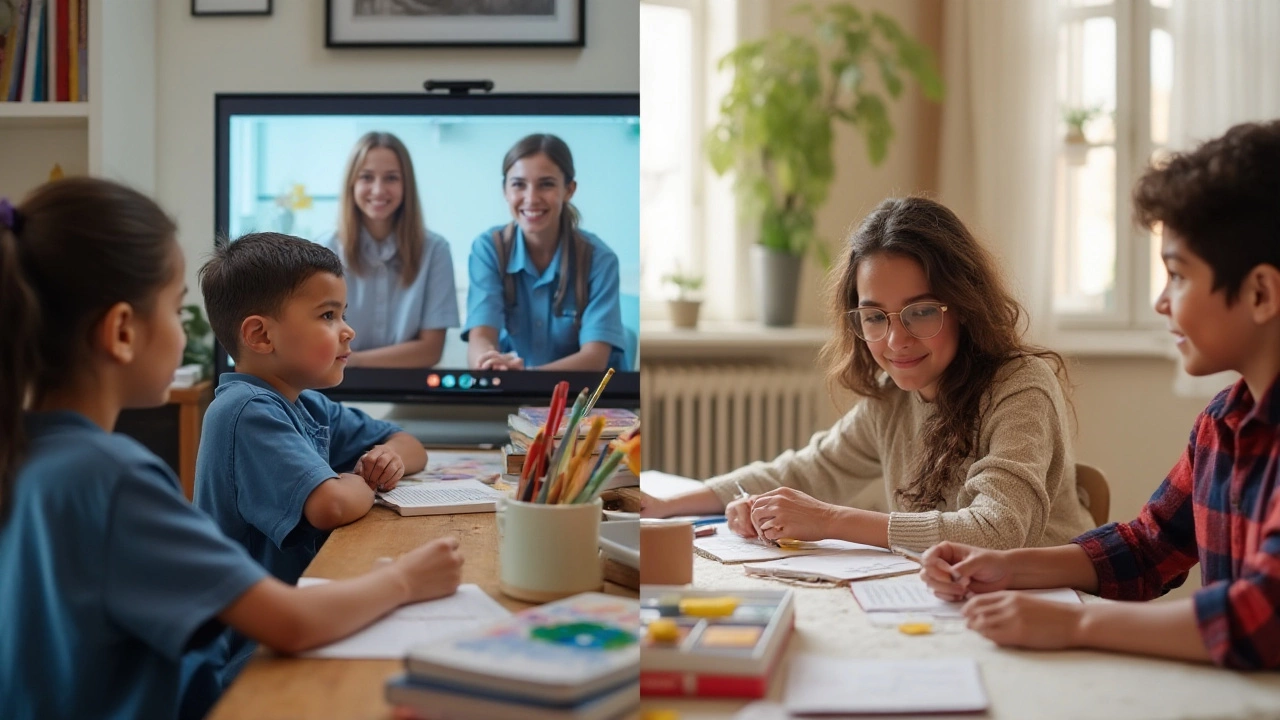In the realm of education, there is often a tangle of terms tossed around that can muddy the waters of understanding. Two such terms that frequently cause confusion are 'distance learning' and 'homeschooling.' While they might sound similar, they represent two distinct approaches with unique methodologies, goals, and implications for both students and parents.
Distance learning has grown exponentially, especially in recent years, offering flexibility and accessibility to learners regardless of location. This educational method depends on technology to deliver instruction from qualified teachers to students scattered across various geographies. It's a virtual classroom experience that brings structure and a curriculum similar to that of traditional schools.
On the other hand, homeschooling is where parents take the helm of their children's education. This personalized approach allows for a customized learning experience, tailoring subjects and lessons according to the child's pace and interests. It involves a hands-on strategy where parents direct educational activities, often outside of standard curriculums, to better suit individual needs.
Deciding between distance learning and homeschooling requires understanding how these systems align with your educational aspirations and lifestyle. Before making a choice, it's pertinent to grasp the strengths and challenges of each, ensuring that both students and guardians are prepared for the journey ahead.
- Understanding Distance Learning
- Defining Homeschooling
- Comparing the Two Methods
- Choosing the Right Path
Understanding Distance Learning
Distance learning, a concept that has existed for decades, largely gained traction with the rise of the digital era, and has since become an educational game-changer for students around the globe. Unlike traditional classroom settings, distance learning demolishes geographical barriers by utilizing the power of the internet to deliver education directly to learners, wherever they might be. This method is typically structured around a virtual learning environment where students interact with pre-recorded lectures, live video sessions, and collaborative digital tools. The flexibility offered by distance learning is unmatched, making it an ideal solution for individuals who balance education with other commitments such as work or family.
One of the significant appeals of online education is its accessibility. Students from rural areas, who previously faced hurdles in reaching educational institutions, can now seamlessly join classes led by qualified teachers without leaving their homes. In the early 2020s, the pandemic accentuated this shift, forcing many institutions to embrace online education methods. Statistics from the National Center for Education Statistics (NCES) demonstrated a surge in online enrolments, highlighting the massive pivot towards digital learning worldwide. It's intriguing how swiftly schools adapted, developing digital curriculums within months to ensure continued education.
Being tech-dependent, distance learning heavily relies on a stable internet connection and suitable devices. Its success fuels the advancement of educational technologies, ranging from simple tools like video conferencing software to complex platforms utilizing artificial intelligence to personalize learning by tracking student progress and suggesting tailored resources. However, this technological reliance also poses a drawback. Students in underdeveloped regions or those facing economic hardships might find it challenging to access necessary devices and connectivity. This digital divide remains a pressing issue that educators and policymakers strive to bridge.
Teaching methodologies have evolved with distance learning. Teachers are no longer seen solely as lecturers; they play the role of mentors and facilitators, guiding learners to develop independent study skills and understandings. To ensure such online settings remain engaging, educators employ a mix of multimedia resources and interactive activities. The integration of gamified elements is known to captivate younger audiences, turning learning into an enjoyable experience. A notable quote by educational researcher Dr. John Elliott states, "Distance learning isn't merely about digital convenience. It's about reframing education to connect with every type of learner on their own terms."
Yet, while the appeal and benefits of distance learning are clear, one can't ignore the challenges accompanying it. Lack of routine, diminished social interactions, and screen fatigue are prevalent concerns among both students and educators. Implementing breaks, promoting virtual study groups, and encouraging offline activities are some noted solutions to combat these hurdles. While the path to online education nirvana seems long, steady progress is observed, championing distance learning as a key player in the education of tomorrow.

Defining Homeschooling
Homeschooling is an educational journey that transforms the home into a learning environment, where parents and guardians take charge of the academic development of their children. Unlike traditional schooling methods or distance learning platforms, homeschooling offers a break from standard educational norms and provides a canvas where learning can be tailored to the unique interests and needs of each student. This method emphasizes flexibility, allowing families to design a curriculum that fits their schedules, values, and educational goals. Parents can evaluate their child's strengths and weaknesses in real-time and adapt lessons to cater to specific talents or address particular challenges. Without the confines of a classroom, homeschooling can happen anywhere - on a kitchen table, a local museum, or even during travels, thus nurturing a learner's curiosity with real-life experiences. In 2023, it was estimated that around 3.7 million students were homeschooled in the United States, a testament to its growing popularity, partly due to its customizable and hands-on approach to learning.
"We do not homeschool to do school at home; we homeschool to learn anywhere." - Unknown
One of the characteristics that sets homeschooling apart is the opportunity to merge educational content with familial or cultural values. Families can choose to incorporate religious studies, emphasize environmental education, or prioritize arts and music, blending core academic subjects like mathematics and science with other knowledge areas that reflect their priorities. This method can also encourage the development of independent learning skills. Children learn to research, ask questions, and find answers, helping them become lifelong learners. Parents have a choice between various recognized outlines and educational models, such as Charlotte Mason, Montessori, or Classical Education, each offering a distinctive approach to the learning process. Alongside these models, resources for homeschoolers have broadened significantly with the growth of technology, providing access to online education materials and virtual tutoring to complement home instruction. Parents can also connect with homeschooling communities, enabling both the educators and learners to network, share resources, or participate in cooperative classes, enriching the educational experience further.
Despite its many benefits, homeschooling is not without its challenges. One of the potential obstacles is the need for significant parental involvement, which can demand time and resources that may not be feasible for every family. Additionally, there can be concerns about socialization, as homeschooled children might not have the same daily interactions with peers as those in traditional schools. Many families counteract these challenges by joining local homeschooling groups or enrolling their children in extracurricular activities to provide social contact and collaboration opportunities. Also, to ensure that homeschooling reflects a robust educational experience, many regions have regulations that parents must adhere to, including submitting educational plans or undergoing regular assessments. These requirements vary widely, so it's vital for parents to be informed about local mandates. However, with thoughtful planning and dedication, homeschooling can be a rewarding education pathway that delights in the diversity and enthusiasm of a child's learning journey.

Comparing the Two Methods
When diving into the differences between distance learning and homeschooling, it's clear that while both serve to educate, their frameworks are vastly different. Distance learning leverages the power of technology to deliver educational content from certified teachers across digital platforms. Its rise has been meteoric in recent years, bolstered by advancements in online education infrastructure. This method often mimics the structure of traditional school environments with set schedules, online classrooms, and a prescribed curriculum. This structured mode benefits students who thrive on routine and accountability.
In contrast, homeschooling is a deeply personal journey led by parents or guardians. It offers a tailor-made educational experience, allowing for a pace and focus unique to each learner. Parents often relish the ability to emphasize certain subjects, cater to their child's learning style, and foster a love for learning outside typical academic boundaries. While distance learning usually depends on institutional guidelines, homeschooling grants considerable flexibility and creativity within educational standards.
Structure and Flexibility
Students in distance learning benefit from interactions with a diverse range of licensed educators and sometimes other students, often creating a classroom-like community. This network can facilitate social learning experiences, discussions, and group projects, enriching the educational journey. However, it may come at the cost of individualized attention, as each teacher manages a larger student base. Homeschooling, with its one-on-one instruction, can often adapt rapidly to a student's evolving interests or struggles, but it places the onus of socializing squarely on the parents' shoulders. The social dynamic here is built through co-ops or group classes involving other homeschoolers.About curriculum, distance learning follows a standard format dictated by educational boards, providing a breadth of subjects essential for comprehensive learning. Homeschooling parents enjoy the liberty to prioritize subjects and customize the learning curve, whether that's diving deep into global history or an early foray into advanced mathematics. It's interesting to note that many homeschoolers find innovative ways to integrate real-world experiences into their lessons, an area where distance learning might lag.
According to the National Home Education Research Institute, "Parents who choose homeschooling are often driven by the family-centric nature of this educational movement, believing it provides a more rounded development for their children."
Resources and Challenges
The resources required differ significantly. Distance learning students need reliable internet access and usually a computer or tablet, but they also receive access to a plethora of digital resources and learning management systems. Homeschooling might demand more diverse resources, from textbooks and workbooks to educational games and hands-on activities. It also requires a significant time investment on the part of the parents, who must not only teach but also plan and customize the educational journey.For many, a blended approach might offer the best of both worlds. Some choose to start with homeschooling in early years, moving to distance learning as the child ages, utilizing the consistent quality of remote instruction while preserving the engagement of independent learning. Ultimately, understanding these methods' innate values and aligning them with family goals can guide the decision-making process in choosing the right educational path for a child.

Choosing the Right Path
When it comes to deciding between distance learning and homeschooling, there is no one-size-fits-all answer. The choice hinges on several factors that parents and learners should carefully weigh. To begin with, consider your child's preferred learning style. Some children thrive in a structured environment with specific schedules and interactions with peers and teachers, which is a hallmark of distance learning. It offers a sense of normalcy and continuity akin to traditional school settings but with the convenience of being accessed remotely. This might be especially beneficial for those who require more accountability and guidance.
Conversely, if your child benefits more from one-on-one attention and a curriculum that can be tailored to their individual interests and pace, then homeschooling might be the better option. This path requires a significant commitment from parents, who should be ready to invest both time and effort into developing lesson plans and creating a conducive learning environment. It's an ideal option for families looking for educational freedom and flexibility.
Financial considerations also play a role in this decision-making process. Distance learning may carry tuition fees akin to those of private or public schools, depending on the institution. These costs are often offset by the access to rich educational resources, expert teachers, and structured curricula. Homeschooling, while often appearing economically feasible since it generally incurs fewer direct expenses, can have hidden costs including materials, extracurricular activities, and potential loss of income if a parent has to leave or reduce working hours to dedicate time to teaching.
Another crucial aspect is the involvement of community and socialization. Distance learning facilitates interaction with other students online, thereby fostering communication skills and collaborative learning experiences. Homeschooling, on the other hand, often requires proactive efforts to ensure adequate socialization, such as joining local homeschool groups, sports clubs, or art classes. This requires diligence from parents to ensure their children benefit from interacting with peers.
Technology also plays a significant role in distance learning. It is essential for families to have reliable internet access and appropriate devices that can support online learning platforms. This can be a limiting factor for some, while for others, the infusion of technology enhances the learning experience by providing access to a wealth of digital resources. Homeschooling, although often low-tech, can also incorporate technology, but it doesn’t depend on it as heavily.
"The choice between distance learning and homeschooling must align with not only your child's educational needs but also the family's overall lifestyle and values," emphasized Dr. Samantha Rivers, an education consultant known for her expertise in personalized learning approaches.
To aid in your decision-making, consider making a list of priorities that are most important for your family's educational goals. Whether it be flexibility, individualized learning, structured environments, or financial feasibility, having clarity on these aspects will lead to a more informed decision. In the end, the right path is the one that best aligns with your child's holistic development and your family's values.






